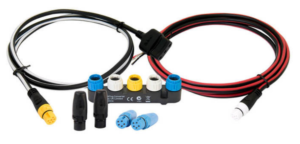Raymarine SeaTalk NG

Fig.: SeaTalk NG connection technology
With SeaTalk NG there is a more powerful successor to SeaTalk, which is based on the CAN bus and has limited compatibility with NMEA2000. With the fairly clear and color-coded connection technology of SeaTalk NG, Raymarine has managed to provide backwards compatibility with SeaTalk, which also supports older devices. The disadvantage, however, is the high price for the proprietary connection technology. However, adapters for other bus systems are also available.
SeaTalk NG benefits:
- Higher data rates: At 250 kbit/s, SeaTalk NG has significantly higher data rates than SeaTalk, which can only transmit 4800 Bd.
- Bi-directional transmission: SeaTalk NG is based on the CAN bus and offers bi-directional transmission so that data can be sent as well as received.
- Reliability: SeaTalk is a reliable network protocol that guarantees data is transmitted correctly. To do this, checksums are used for the telegrams and faulty telegrams are resent.
- Easy Wiring: Units easily plug into a SeaTalk NG bus via colour-coded connectors. This minimizes wiring errors.
Disadvantages of SeaTalk NG:
- Proprietary: SeaTalk NG uses a proprietary protocol in some parts, but is also compatible with NMEA2000 to a limited extent.
- Expensive connection technology: SeaTalk NG uses its own proprietary connector format, which is quite expensive and cannot be substituted with other connectors. Other connector formats such as NMEA0183, NMEA2000 and SeaTalk are also supported via adapters.
- Lack of extensibility: SeaTalk NG cannot be expanded with new data content or data formats. The data transmission is designed purely for sensor data. Image data or other large amounts of data cannot be transferred via SeaTalk NG.
Overall, SeaTalk NG offers similar performance to NMEA2000. Proprietary extensions to the protocol allow Raymarine products to integrate better with SeaTalk NG than is possible with NMEA2000. Proven on many boats, SeaTalk NG is considered a reliable bus system, but it comes at a price.
open-source
There is no separate open source implementation for SeaTalk NG that supports the special features of SeaTalk NG. Rather, with the Open source implementation to NMEA2000 by Timo Lappalainen, part of SeaTalk NG can be used as long as it is NMEA2000 compatible.